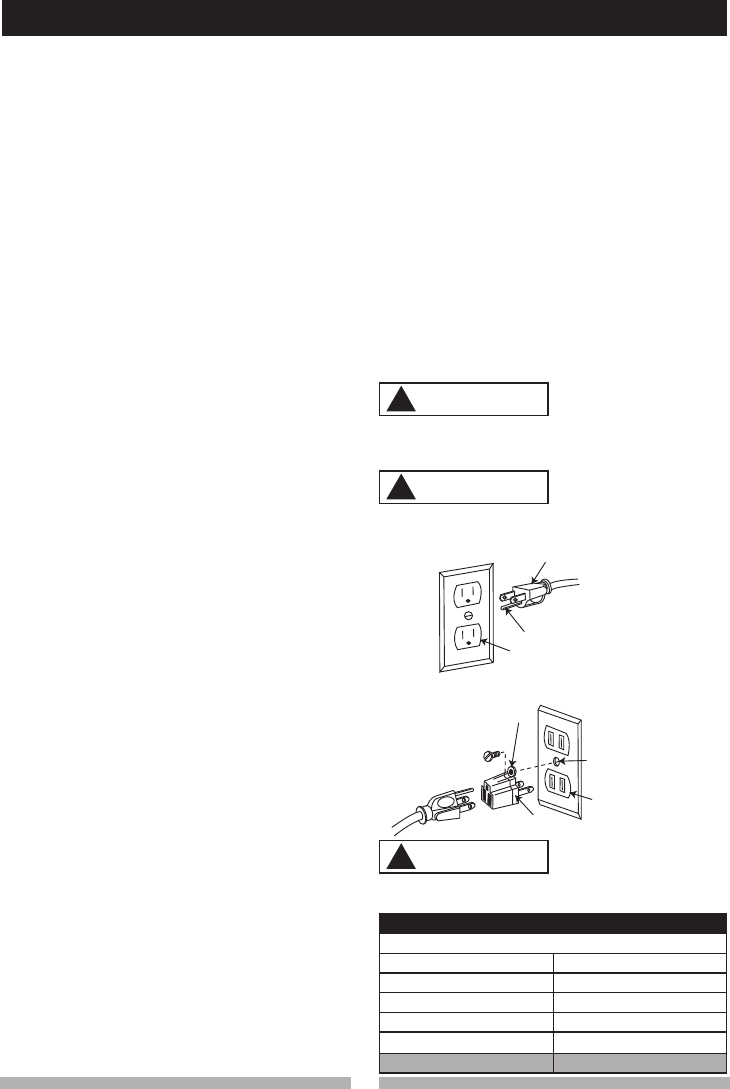
6 7
6 7
ELECTRICAL REQUIREMENTS AND SAFETY
GROUNDING INSTRUCTIONS
IN THE EVENT OF A MALFUNCTION OR
BREAKDOWN, grounding provides a path of
least resistance for electric currents and reduces
the risk of electric shock. This tool is equipped
with an electrical cord that has an equipment-
grounding conductor and a grounding plug. The
plug must be plugged into a matching receptacle
that is properly installed and grounded in
accordance with all local codes and ordinances.
DO NOT MODIFY THE PLUG PROVIDED.
If it will not fit the receptacle, have the proper
receptacle installed by a qualified electrician.
IMPROPER CONNECTION of the equipment
grounding conductor can result in risk of electric
shock. The conductor with the green insulation
(with or without yellow stripes) is the equipment
grounding conductor. If repair or replacement of
the electrical cord or plug is necessary, do not
connect the equipment grounding conductor to a
live terminal.
CHECK with a qualified electrician or service
person if you do not completely understand the
grounding instructions, or if you are not certain
the tool is properly grounded.
USE only three-wire extension cords that have
three-pronged grounding plugs with three-pole
receptacles that accept the tool’s plug. Repair or
replace damaged or worn cords immediately.
GUIDELINES FOR EXTENSION
CORDS
USE THE PROPER EXTENSION CORD. Make
sure your extension cord is in good condition.
Use an extension cord heavy enough to carry
the current your product will draw. An undersized
cord will cause a drop in line voltage resulting
in loss of power, overheating and burning out
of the motor. The table on the right shows the
correct size to use depending on cord length
and nameplate ampere rating. If in doubt, use
the next heavier gauge. The smaller the gauge
number, the heavier the cord.
Make sure your extension cord is properly
wired and in good condition. Always replace a
damaged extension cord or have it repaired by a
qualified technician before using it. Protect your
extension cords from sharp objects, excessive
heat and
damp or wet areas.
Use a sep
arate electrical circuit for your tool. This
circuit must not be less than #12 wire with a 20 A
time-lag fuse or a #14 wire with a 15 A time-lag
fuse.
NOTE: When using an extension cord on a
circuit with a #14 wire, the extension cord must
not exceed 25 feet in length. Before connecting
the motor to the power line, make sure the switch
is in the off position and the electric current is
rated the same as the current stamped on the
motor nameplate. Running at a lower voltage
will damage the motor. This tool is intended for
use on a circuit that has a receptacle like the one
illustrated in Fig. 1.
Fig. 1 shows a three-pronged electrical plug and
receptacle that has a grounding conductor. If a
properly grounded receptacle is not available,
an adapter (Fig. 2) can be used to temporarily
connect this plug to a two-contact grounded
receptacle. The adapter (Fig. 2) has a rigid lug
extending from it that MUST be connected to
a permanent earth ground, such as a properly
grounded receptacle box.
In all cases, make certain the receptacle is
properly grounded. If you are not sure, have a
qualified electrician check the receptacle.
This tool is for indoor use only. Do not
expose to rain or use in damp locations.
Fig. 1
Fig. 2
Three-Pronged Plug
Grounding Prong
Properly Grounded
Three-Pronged
Receptacle
Grounding Lug
Make sure this
is connected
to a known
ground.
Two-Pronged
Receptacle
Adapter
This tool must be grounded while in use to
protect the operator from electric shock.
MINIMUM GAUGE FOR EXTENSION CORDS (AWG)
(When using 120 volts only)
Ampere Rating Total length of Cord
More Than Not More Than 25ft. 50ft. 100ft. 150ft.
0 6 18 16 16 14
6 10 18 16 14 12
10 12 16 16 14 12
12 16 14 12 Not Recommended
!
!
!
WARNING
!
WARNING
!
WARNING
!


















